Foreign Insulators
by Marilyn Albers
Reprinted from "INSULATORS - Crown Jewels of the Wire", May 1983, page 5
The Algoma Eastern Railway
A while back, in the December '80 issue of Crown Jewels there appeared in Jack
Tod's column the following letter from Terry Smith (Port Huron, Michigan)
inquiring about an insulator marking.
- - - - - - - - -
I found a really beautiful baby beehive
with an unusual marking, and I'm wandering if you've heard of it before. It's
similar to the glass CD-143's, quite like the ordinary C.P.R. and C.N.R.
porcelain beehives we see (sketch at right). The glaze is a glisteny white, and
the "A.E.R." marking on the crown is underglaze in dull green ink.
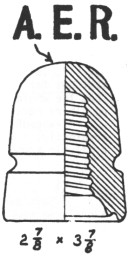
I
found this on a spur of the Algoma Central Railway Just north of Sault St.
Maria, Ontario. It has to be uncommon, since I checked the entire Algoma system
and found no others. This railway links together many old mining towns, and it
has been in operation for over a century. Sure would like to know who made it
and when.
Terry Smith,
Port Huron, Mich.
- - - - - - - - - -
Dear Terry:
Certainly one of our
readers will be able to attribute this marking. I've never seen any of this
style made by Pittsburg which were of such nice quality, so maybe this one was
made in England. It's tempting to guess at the name by initial-matching, but
every time I try that it just proves how unlucky I am.
Jack
Jack and I were
corresponding about that time concerning the possibility of putting together a
book(s) on foreign insulators, and he mentioned the fact that Terry had sent him
the A.E.R. insulator for a look-see. He asked me what I knew about it. "Any
ideas as to AER? Here again, if you just guess it's Algoma Electric Railway or
some such, that's cheating!" I had not heard of this marking, so the
question just sort of went unanswered, and when our book Worldwide Porcelain
Insulators was published, the A.E.R. marking was shown under
"Canada ..... Miscellaneous Insulators and Markings" with only this to
say: "The A.E.R. is unattributed, but it was found on a spur of the Algoma
(Electric?) Railway in Ontario."
Please have patience while I take you the
long way around this story, but all the pieces fit! In August 1982 Oscar Chaput
(Wheatley, Ontario) wrote to Jack Tod asking if he knew the possible
manufacturer of some similar porcelain insulators he'd found, only with the
green ink marking T & N 0 Ry (Temeskaming & Northern Ontario Railway).
Neither Jack nor I knew, but Oscar and I began corresponding, and I could tell
his curiosity was also piqued by the mystery of the A.E.R. marking and that he
intended to find out who the manufacturers were for both of these insulators.
His contact with the Algoma Central Railway in Sault Ste. Marie paid off
handsomely, and on February 18, 1983, he wrote:
|
Dear Marilyn,
"It's me
again. I just received a very interesting package of information from Mr. Marvin
G. Ross, supervisor of the Signals and Communications branch of the Algoma
Central Railway. He has an A.E.R. insulator in his possession which he claims
was made for the Algoma Eastern Railway. To support his claim, he also sent me a
copy of a Bill of Sale for a parcel of land sold to A.E.R. in the District of
Sudbury dated March 7, 1913. As well, I received two copies of survey sketches
for this railway dated May, 1911. Mr. Ross believes that the whole railway had
these insulators at one time, but no others have been found as of this date.
"I thought you might be interested in this information. Apparently, a book
regarding the Algoma Eastern Railway is available from:
Mr. Dale Wilson
158 Odie
Street
Sudbury, Ont. P3L 2C8
"I have sent for a copy of same. If you are
interested, I can send you copies of the material I received from Mr. Ross. I am
still waiting to hear from Ontario Northland Railway regarding the T. & N.
0. Ry. insulator.
"Hope this clarifies the A.E.R. embossing mentioned in
your book. As soon as I get more, I will pass it on."
Oscar
|
One month later
Oscar sent me a whole packet of information on both railways. There was so much,
in fact, that in order to do justice to each one, I will save the story about T.
& N. 0. Ry. until next time.
In the packet was a copy of Dale Wilson's book
Algoma Eastern Railway and a portion of his letter which follows:
|
Dear Mr.
Chaput,
. . .
The extra copy of Algoma Eastern Railway is enclosed and I would be
quite happy to have Mrs. Albers use the book as a reference in her research. I
assume that a use of quotations from the book, giving the source, would be the
way she would go.
"As an aside, you might be interested in knowing that the
A.E.R. set up a subsidiary, the Algoma Eastern Telephone Company (or very
similar title) that apparently not only provided phone service along the
railway's lines, but extended service 'some distance' on to the Manitoulin
Island. I know nothing more about this than what is written above, and my
sources might not be 100% accurate. That phone system, under that name (or
similar) outlasted the railway under the A.E.R. name, but was eventually
swallowed up by the Bell system .... You may have access to records of that
taking place, and that would be the logical place to check what took place, when
and to what extent. . . . ."
Sincerely,
Dale Wilson
|
Mr. Wilson's book makes marvelous
reading! It is rich in detail and there are pictures of the locomotives and
railway cars used by Algoma Eastern, as well as railroad stations and bridges
along the A.E.R. route. Sprinkled throughout the book one can see time tables,
railway passes and other documents. It would be impossible to include it all in
an article of this length, but I have tried to at least capture the basic story.
Obviously the author had fun researching material for his book. His enthusiasm
(matched only by that of Oscar Chaput) comes right through the pages. With Mr.
Wilson's permission, most of what you'll read below is quoted directly from his
work. We begin with a map showing the A.E.R. route.
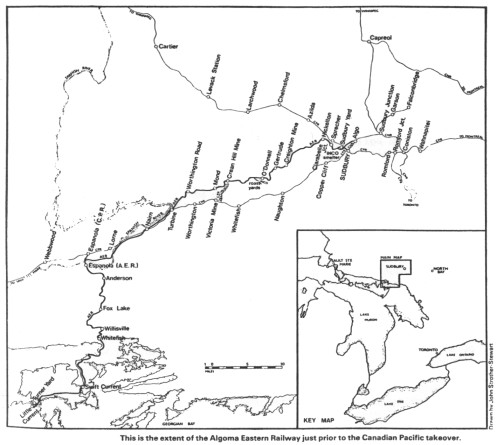
Large Image (117 Kb)
The Dream
Railways made
Canada. Living in a country dominated by two transcontinental railways,
Canadians sometimes tend to forget that smaller lines also contributed to
building their nation. Such a line was the Algoma Eastern Railway. Had it been
human, the AER would have had a stunted childhood, a boisterous adolescence and
short but vigorous adult life.
The railway extended eighty-seven miles from
Sudbury, centre of the world's largest nickel mining region, to Little Current
on the Manitoulin Island, just off the north shore of Lake Huron. As might be
expected, the Algoma Eastern served the nickel industry, opened up Manitoulin
Island and brought rail service to the areas between. While these are worthy
achievements they came nowhere close to the main aims spelled out in the company
charter. About the only claim to modesty the Algoma Eastern charter might have
made was that, almost alone among northern Ontario railway ventures, it did not
promise to go to Hudson Bay.
The AER story had its start just before the turn of
the century in Sault Ste. Marie where Francis H. Clergue, an American financier
and dreamer, had begun the creation of an industrial empire with his Lake
Superior Corporation. What this company and subsidiaries achieved was
magnificent. They made iron and steel; generated hydroelectric power in both the
United States and Canada; ran an international ferry service, two street-car
systems and a fleet of Great Lakes' ships; mined iron ore in northern Ontario
and coal in West Virginia; quarried limestone in Michigan and last, but far from
least, operated almost four hundred miles of railway. Amazingly, all this did
not fulfill Clergue's dreams.
In 1894, Clergue had begun by taking over Sault
Ste. Marie's power company. Since no industry appeared to use the electricity,
he created a customer by building a pulp and paper mill. In the paper making
process he anticipated using sulphur, a waste by-product of the Sudbury area
nickel ore processing. Canadian Copper Company, one of the predecessors of
International Nickel, refused to deal with him. Never a man to think small,
Clergue decided to do his own nickel mining and smelting.
Thus it was in 1889
that the Lake Superior Corporation entered the affairs of Sudbury by purchasing
two nickel properties west of town, naming them Gertrude and Elsie after
Clergue's sisters. The metal obtained was initially just a by-product but
quickly came into its own when experiments conducted in the Sault showed it was
economical to use Gertrude and Elsie nickel as a steel alloy. Shortly after, a
Lake Superior subsidiary, the Algoma Steel Corporation, negotiated a contract to
supply nickel-steel to Krupp, the weapon-makers of Germany.
The Gertrude and
Elsie mines required rail transport, so Clergue took over the charter of the
Manitoulin & North Shore Railway, incorporated in 1888. This line had been
intended to connect Manitoulin Island with the mainland and charter revisions up
to 1894 permitted a junction with the Canadian Pacific branch line between
Sudbury and the Sault. Although subsidies had been granted, it is unlikely any
were actually paid since no construction took place on this original M&NS.
Clergue obtained a Federal charter for the railway in 1900 which called for
lines from Sudbury to Little Current, from Little Current to the southeast
corner of Manitoulin Island, across Georgian Bay to Tobermory, and from there to
Meaford, Wiarton, and Owen Sound. Since this routing involved ferry service
across Georgian Bay, it is interesting to speculate how things would have run
during the winter months. However, it was in planning, not execution, where
Clergue's talents were found. In fact, the dream grew when Clergue added to the
charter the intention of running several lines through the Sudbury district to
tap mining and forestry traffic, plus a westward extension to link up with his
other railway, the Algoma Central & Hudson Bay.
Manitoulin & North Shore
construction began at the Canadian Pacific main line a short distance northwest
of CP's Sudbury station. The first fairly wide spot of level ground, in a
section of Sudbury now known as Little Britain, was chosen as the site of the
terminal yard. At first the terminal facilities consisted only of two or three
tracks, coal and water facilities and a two stall engine house. This was May of
1900.
Moving west the first station on the line was Clarabelle (Mile 4.8), entry
to the smelter complex at Copper Cliff, where the M&NS met track of the
Canadian Copper Company, soon to be known as International Nickel or INCO. Being
by far the largest nickel producer in the region over the years, INCO was to be
an excellent customer for the M&NS and its successors. Next came the Elsie
mine with a short spur, just past Mile 5 and approximately the site of present
day Murray mine. Hilltop Siding was at Mile 8 for some years until some original
thinker changed the name to Milate. At Mile 12 INCO's Creighton mine was
beginning production and would ship its ore to Clarabelle. Finally, the sixty-
pound rail reached Gertrude mine, where ore was already being brought to the
surface and a smelter was under construction. This represented fourteen miles of
main line and it took almost a year to build.
At this early stage the M&NS
possessed three locomotives and ninety-nine cars, one being for passengers.
Traffic patterns were simple with ore from the Elsie going to Gertrude, ore from
Creighton moving to Clarabelle and finished or semi-finished products leaving
the railway at Sudbury.
Early in 1903, a spur was pushed in from Mile 10 to
serve the Haight & Dicksen Lumber Company and a new mine, the North Star.
The latter was owned by the Mond Nickel Company and its ore was shipped east to
Sudbury on the M&NS and then west twenty-one miles on the C P Sault branch
to the Mond smelter at Victoria mine. It is estimated that at this time
somewhere between a thousand and two thousand people lived along the right of
way of the Manitoulin & North Shore.
The stage was set. Although only a few
miles in length the railway already had solid industrial and passenger traffic.
It seemed certain that a very few summers of construction would see the M&NS
complete its lines within the Nickel Belt, to the Sault and to southern Ontario.
Unfortunately, this was not to be.
A Pause and New Beginnings
In mid 1903,
disaster struck. The Lake Superior Corporation suddenly found itself in a very
dangerous financial position, largely due to some of Francis Clergue's policies.
In part, the rapid expansion of the Corporation was at fault. The most damaging
factor, however, was the habit of the Corporation's subsidiaries of doing too
much business with one another and not enough with outside customers. The
M&NS was less guilty of this than most other parts of the operation, since
it received considerable revenues from INCO and Mond Nickel. The immediate
result in the Sudbury area was the closing of the smelter and two mines
belonging to the Corporation. They were never to reopen. The railway halted all
construction and related activities, concentrating on what business was
available along the fourteen miles of track. In the Sault, Clergue was eased out
of control of his company and away from his dreams. Even though he remained a
director for some time, he was apparently forbidden any say in policy.
With only
fourteen miles of main line, the M&NS managed quite well while its parent
and related companies struggled to survive. Timetables for 1905 show two
passenger trains daily each way over the whole line, suggesting that Gertrude
continued to serve as a town site. Creighton mine shipped an average of fifteen
thousand tons of ore per month throughout this period and contributed greatly to
healthy railroading. For the year ending June 30, 1905, the railway showed net
earnings of almost a thousand dollars a mile! Some construction was even done
during these years, after a fashion. For several summers (probably to protect
charter rights) a single man, armed with shovel and wheelbarrow, was employed to
extend the line.
From 1905 the state of Canadian economic conditions improved
and the railway building mania returned to the land in the form of two
transcontinental and numerous branch lines. A revitalized Lake Superior
Corporation was again in an expansive mood and the Manitoulin & North Shore
was soon to benefit.
Between 1907 and 1910, rails inched from Gertrude to Crean
Hill (Mile 22). The Vermillion River was crossed at Mile 18 with a massive
bridge of steel spans supported by two huge abutments and a centre pier, all of
masonry. This and the later swing bridge at Little Current were the two major
engineering works on the railway.
Officially the Manitoulin & North Shore
became the Algoma Eastern Railway on May 11, 1911; and the usual confusion when
any company changes its name was present in this case. Through 1909 and 1910
sources such as newspapers, maps, mining publications and the Official Guide of
the Railways had frequently used the title Algoma Central when they meant the
M&NS. Certainly there were close relations between the two railways as
supervisory people moved freely between Sudbury and Sault Ste. Marie and certain
rolling stock and equipment lettered for the ACR was based on the M&NS. (And
easy to see how the A.E.R. insulator found by Terry Smith was being used on the
Algoma Central Railway! - M.A.) There is no satisfactory explanation why the
name Algoma Eastern was chosen. Indeed, the name brought certain problems in
tracing cars and paying for repairs done on other railways, since there was
another AER -- the Arizona Eastern Railway, a part of the Southern Pacific rail
empire. Perhaps the new name was a form of bureaucratic tidying-up which had
most Lake Superior subsidiaries named Algoma "something".
Finally, In
April of 1913, the rails reached Turner (mile 86), the site of yard and dock
facilities for Little Current. The swing bridge across the narrow channel to
Little Current and the island was completed in October and the Algoma Eastern
could boast a mainline mileage of 87.1 and completion of plans as laid down in
the original charter of the Manitoulin & North Shore Railway.
War and the
Twenties
An era was ending. The long years of comparative peace would end in the
holocaust of World War I and much of the world would never be the same. Foreign
nationals were already being called home for military service as early as 1911,
and new immigration to Canada slowed to a trickle. The transcontinental dreams
of Canadian, Northern and Grand Trunk Pacific were doomed and smaller rail lines
were affected in various ways, usually badly. In contrast, the Algoma Eastern
rolled onwards with few changes, since it was a major carrier of nickel ores and
nickel was one of the vital parts of the war machine.
Algoma Eastern prosperity,
during and immediately after the war, brought rumours of a possible sale. The
Sudbury Star wrote that the interested parties included Canadian Pacific,
Canadian Northern and even Grand Trunk whose nearest rail was eighty miles away
in North Bay. The most likely purchaser was the Canadian Northern, said the Star. Nothing concrete developed from the rumours (Canadian spelling) but it is
interesting to speculate if, in some dusty archive, there still exist takeover
plans and the reasons for them.
The decade beginning in 1920 was a period of
contrasts for the Algoma Eastern. The demand for nickel was so depressed that
many mines and smelters closed down altogether or at least worked at such a
reduced rate as to cause a hardship for the railway. Some compensation did come,
however, from the forest industry, general commercial business and the coal
traffic. Also, passenger traffic seems to have been healthy, particularly in the
tourist season.
Gradually, through the 1920's the demand for nickel increased
and mining throughout the Sudbury area recovered from its post war slump.
To the
Canadian Pacific
Change came in 1929. The Ontario government belatedly came to
the conclusion that open air roasting of nickel ores was undesirable and must
stop. A law to this effect was passed and ore traffic on the AER was somewhat
reduced.
Even with these problems, the Algoma Eastern was still an attractive
property and once more rumours of a sale were heard. When the General Manager of
Canadian Pacific's Eastern line visited Sudbury and then went on to the Sault in
company with an official of the Lake Superior Corporation, the rumours began to
take on real substance. Possible Canadian National interest in the Algoma
Eastern was denied by none other than the C N President, and the only other
possible bidder, INCO, was not heard from at all. Canadian Pacific it was to be,
and the AER's days as an independent were numbered.
Details became public
knowledge in March of 1930. Rather than an outright purchase, Canadian Pacific
had leased the Algoma Eastern, lock, stock and locomotive, for 999 years! The
cash involved came to three million dollars and the CPR assumed liability for
over two million dollars worth of the small railway's construction bonds. The
last financial statement published by the AER showed that better than one-third
of revenues was clear profit. The CPR had acquired a money maker!
Then came the
"Great Depression", which meant many different things. No two people,
regions or even countries shared exactly the same circumstances in the Thirties,
and perhaps the only certainty was that nothing much prospered. The Sudbury area
was hit and Canadian Pacific felt the pinch. Beginning in 1931, in the interest
of economy, a few miles here and a few miles there were pulled from service,
even to the lifting of the actual rails. Many abandoned sections of track became
blocked with ties and piles of crushed slag. Little by little through the
following years the number of miles of original line shrank.
Just west of
Espanola, about one mile of the former Algoma Eastern main line remains in
place, but only for the humble purpose of car cleaning and storage.
As in the
rest of Canada, passenger service declined after World War II as the automobile
took over. By 1963, the former Algoma Eastern was a freight only operation, and
a rare visit by a Canadian Pacific business car only serves to underline what
has been lost.
Perhaps.....?
Two questions remain: Had the Canadian Pacific not
taken over the Algoma Eastern, could the small railway have survived to the
present? Is it possible that CPR might rebuild the abandoned portions of this
line?
There can be no definite answers. No doubt the Depression years would have
been difficult for the AER and the parent company could have offered no help
since it was itself doomed. However, the case of the Algoma Central offers
itself as an interesting comparison. The ACR became and remained independent
because bondholders stubbornly retained control through years of insolvency.
Since the Algoma Eastern financial record over the years had been consistently
better than that of the ACR, possibly its Depression fortunes might have been
better as well. Nickel mining and processing, although reduced during the
1930's, was not affected as badly as some industrial activities.
The Algoma
Eastern story began as a dream, tempered only slightly with sensible economics.
There were twists in the story that even Francis Clergue couldn't have imagined,
although success more often than failure seems to have been the theme. Perhaps
one can dream a little further.
Some pictures follow that were taken from Mr.
Wilson's book. Included also is a copy of the Crown Land Grant issued to the
A.E.R. dated April 5, 1913.
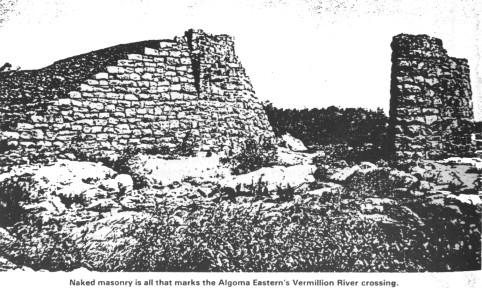
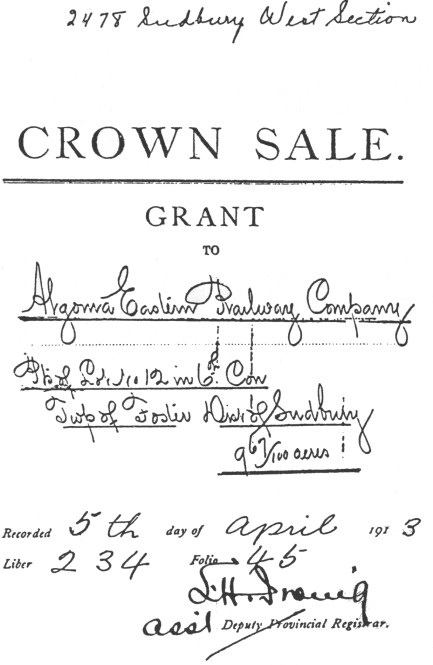
Large Image (105 Kb)
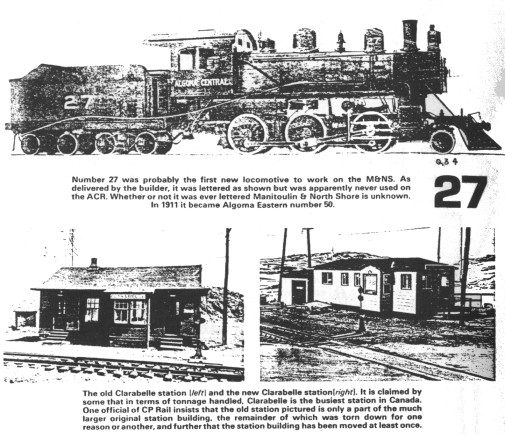
Large Image (261 Kb)
The actual Bill of Sale for a parcel of land sold to
the AER in the District of Sudbury (not included) shows the purchase price to be
$9.67. My! How times have changed!
Who manufactured the U-1131 A.E.R. insulator?
It is so like the similar white porcelain insulator marked CPR that we know was
made by Pittsburgh High Voltage Insulator Company in the U.S.A., and yet it is
too fine a quality to have been one of their products. Is Jack Tod right in
believing it could have been made in England? In the book Canadian Insulators by
Colin McIntosh, the author says, "There have been a great many different
varieties and styles of crockery insulators manufactured and used in Canada. In
addition, crockery insulators have been imported from the United Kingdom, Germany, the United States, Japan and perhaps other countries. Most of the styles
mentioned here (in his book) are assumed to have been made in Canada, but very
few pottery insulators are marked with the maker's name -- making positive
identification very difficult." I have a feeling Oscar Chaput will not rest
until he has turned over every possible stone in an effort to find out!
Many
many thanks to you, Oscar, for your perseverance and for a fine contribution to
our hobby. And, Dale Wilson, you put together an unforgettable story of the
Algoma Eastern Railway, and we appreciate your support and interest by sharing
with us.
|
